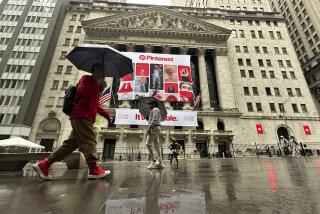Will Bond Market Backfire? : Inflation: Enthusiastic investors are betting on a slow economy. But a surge in prices of some key products may signal trouble ahead.
Investors are desperate to lock up their money in long-term bonds this year, in large part because they believe that inflation is no longer a threat.
But commodity markets are singing a different song: Prices of many basic foodstuffs and industrial commodities have jumped in recent months, suggesting higher inflation is in the pipeline.
The sudden disparity between the bond and commodity market trends is causing heightened concern on Wall Street. Given the cash avalanche that continues to pour into bonds, analysts worry that the market could violently reverse if investors decide that inflation this year will be higher than the 3% now universally anticipated.
With bond yields at historic lows, a rise in inflation expectations even to 4% for 1993 could make a big difference to bond buyers.
So far, however, the steamrollering bond market is paying virtually no attention to commodity prices:
* The yield on 30-year Treasury bonds fell to another record low of 6.73% on Thursday, down from 6.78% Wednesday and off sharply from 7.20% in early February.
* Meanwhile, the Commodity Research Bureau’s index of 21 key commodities zoomed 1.38 points to 206.47 Thursday, the highest level since last July. The CRB has jumped 3.7% since Feb. 5.
Many economists, while admitting that they are watching the CRB, say the recent gains in some commodities constitute little more than a technical bounce. Indeed, it was only a month ago that the index hit a six-year low of 198.38.
Also, commodity prices overall remain far below the peak levels of 1981, when the CRB reached 335 in the final inflationary frenzy of that era.
And with Europe and Japan in recession and our own economy apparently slowing again, many experts say it is difficult to believe that prices of any goods--especially simple commodities--could be on a sustainable upswing. Where’s the demand to make price increases stick? economists ask.
What’s more, the greatest source of pressure on prices of goods and services is labor expense, which is typically two-thirds of production costs, notes John R. Williams, managing director at Bankers Trust Global Economics in New York.
“The key to inflation in the longer term is wage and benefit costs, and those have so far been very well-contained,” Williams says. “It seems like there’s still a lot of excess capacity in the economy,” including an excess of educated people trying to find decent work.
Still, the breadth of the rise in commodity prices this year has taken Wall Street by surprise. “I think it’s something to start worrying about,” says Edward Yardeni, economist at C.J. Lawrence Inc. in New York.
Where prices are going up:
* Lumber. The price of wood has rocketed 60% just since year’s end, causing significant problems for builders trying to hold housing costs down. The National Assn. of Home Builders estimates that the cost of building a new, 2,000-square-foot home has jumped $4,500 since fall because of soaring lumber prices.
Experts blame a combination of heavy demand (especially for rebuilding South Florida after last year’s big hurricane) and loss of logging rights on large tracts of federal land in the Northwest because of the spotted owl controversy.
* Energy. Despite the weak global economy, a cold winter in much of the Northern Hemisphere has kept fuel oil and natural gas prices high. More recently, crude oil prices have risen on the belief that OPEC members will make good on their latest promises to restrain production.
Andrew Addison, a technical markets analyst in Franklin, Mass., argues that “the supply-demand equation for energy has shifted from negative to neutral.” That’s giving traders much more confidence to bid up oil futures prices, he says.
* Grains and meats. American grain prices have been buoyed by expectations of greater export demand, especially by the former Soviet Union. Livestock prices, meanwhile, have risen in part because the cold winter in the Midwest has caused many animals to drop weight, effectively cutting future supply.
What about gold--the one commodity that’s supposed to signal inflation more accurately than any other? Gold has actually slipped in price this year. But some Wall Streeters believe that the metal is poised for big gains.
Reason: Shares of gold mining companies have surged nearly 9%, on average, so far this year. “The stocks always lead the metal price,” notes William Tehan, a gold specialist at money manager P. R. Herzig in New York.
Analysts say they’ve been impressed with gold’s ability to hold up, despite heavy sales of bullion earlier this year by Belgian and Dutch central banks.
But Tehan, a bull on gold because he sees a depreciating dollar ahead, admits that he doesn’t see other commodity prices headed much higher. He notes that copper in particular has been weak. As a key metal used in industry and construction, copper “usually moves before everything else” when economic demand is pulling prices up, Tehan says. For now, “copper isn’t going anywhere.”
Lacy Hunt, economist at CM&M; Inc. in New York, believes that the winter commodity surge will fade as the American economy weakens under the psychological weight of President Clinton’s proposed tax increases.
And in any case, he says, bond buyers who should normally be paranoid about inflation have a more pressing concern: Many of them are individual investors who are sick of earning 2.7% in money market funds. Even at 4% inflation, those buyers may view a 6.7% Treasury bond as a fair deal, Hunt says.
C. J. Lawrence’s Yardeni agrees. “This is a new crowd in the bond market,” he says. “Mom and Pop aren’t watching the CRB index.”
Commodity Prices: Warning Flag for Bonds?
Even as bond yields have plunged in recent weeks, an index of key commodity prices has risen sharply. Higher commodity prices normally signal inflation--the No. 1 enemy of the bond market. How the Commodity Research Bureau index has gained versus the change in the 30-year CRB index: March 4: 206.47
30-year T-bond: March 4: 6.73%
Source: Commodity Research Bureau
Key Commodity Prices
How futures prices on some commodities have changed since year’s end:
Nearest-term futures: Pct. Commodity Dec. 31 Thurs. chng. Lumber (thousand feet) $284.10 $454.90 +60.1% World sugar (pound) $0.084 $0.102 +21.3% Oil (barrel) $19.50 $21.07 +8.1% Wheat (bushel) $3.53 3/4 $3.77 1/4 +6.6% Live cattle (pound) $0.77 $0.81 +4.6% Soybeans (bushel) $5.68 3/4 $5.81 1/2 +2.2% Gold (ounce) $333.10 $329.00 -1.2% Copper (pound) $1.03 $0.94 -8.6%
Source: Futures exchanges
More to Read
Inside the business of entertainment
The Wide Shot brings you news, analysis and insights on everything from streaming wars to production — and what it all means for the future.
You may occasionally receive promotional content from the Los Angeles Times.










